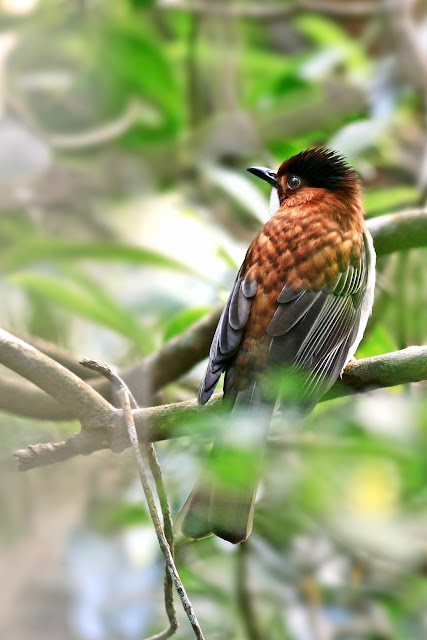Having heard from several reports saying that flycathcers are present in Lung Fu Shan, I persistently went there to look for them. But it is a pity that the visits were in the afternoon. This may have decreased the probability of the encouter of those flycathers. Nonetheless, there were some good birds. They indicate the underway migration.
Two Chestnut Bulbuls were seen once feeding on a fruiting tree in a large flock of bulbuls. Mixed in the flocks are Japanese White-eyes. Hearing the calls of the White-eyes means that one is very likely to come across with a bird wave. But looking for spectacular species in bird waves is not easy. Fruiting trees are possible stopovers which lengthen the available time for observing the composition of species in a bird wave. The scale-like feathers on the back of the Chestnut Bulbul is quite interesting.

Then Daurian Redstarts have been seen along the hiking trails. Most individuals are female. This photo shows one with scaly legs, a disease caused by parasitic mites. This sparks the thought of the origin of this bird. It is suspected this particular female Daurian Redstart was once a captive bird. First, its tail feathers are bent upward, possibly resulting from the limited room for activity in a cage. Second, domestic birds are prone to the disease. Its owner might have released the bird instead of healing it. But there are sound counter-arguments. Scaly legs are present on wild birds. Photos of diseased forest birds have been circulated online. The bent tail feathers may be the result of the activity style of this diseased bird. In addition, caged birds of this species are often male. The relatively dull plumage of female birds are less attractive to bird owners. The likelihood of the captivity origin of this bird is reduced. Where this bird came from remains a mystery.

Near the entrance of the Lung Fu Shan Country Park, an Ashy Drongo was seen. Another bird watcher has speculated that it would spent the winter in Lung Fu Shan. Ashy Drongo feeds on air-borne insects. It is a pleasure to appreciate its flight track when it attempts to catch one. The country park provides a resourceful wintering habitat for a large community of birds, not just only this Ashy Drongo. The conservation of country park is justifiable for the sake of these wild birds which contribute to the biodiversity-rich character of Hong Kong.
